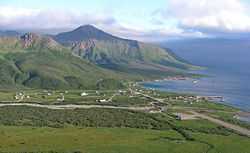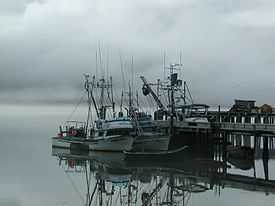False Pass, Alaska
| False Pass | |
|---|---|
| City | |
 | |
|
Nickname(s): "The Pass"  The City of False Pass as seen from the south. | |
 False Pass | |
| Coordinates: 54°49′40″N 163°23′57″W / 54.82778°N 163.39917°W | |
| Country | United States |
| State | Alaska |
| Borough | Aleutians East |
| Incorporated | October 19, 1990[1] |
| Government | |
| • Mayor | Tom Hoblet[2] |
| Area | |
| • Total | 68.3 sq mi (176.8 km2) |
| • Land | 26.9 sq mi (69.6 km2) |
| • Water | 41.4 sq mi (107.2 km2) |
| Elevation | 30 ft (9 m) |
| Population (2010) | |
| • Total | 35 |
| Time zone | Alaska (AKST) (UTC-9) |
| • Summer (DST) | AKDT (UTC-8) |
| ZIP codes | 99583 |
| Area code | 907 |
| FIPS code | 02-24660 |
| Website | City Website |
False Pass (Isanax̂[3] in Aleut) is a city in Aleutians East Borough, Alaska, United States. Isanax̂ (variously spelled Issannakh, Isanak etc.) is the Aleut name for present day Isanotski Strait and means gap, hole, rent, or tear in the Aleut language which was rendered as Isanotski (or Issanakskie, Isanotskoi, Isanakh etc.) in transliterated Russian. The strait appears as Исанакъ in 1802 and Исаноцкый in 1844 on Russian maps.[4][5][6] Isanotski Strait lies between the tip of the Alaska Peninsula and Unimak Island, the first of the Aleutian Islands and it connects the northern Gulf of Alaska with the Bering Sea. This strait was used for safe passage for millennia by Aleuts and later by the Russians during their occupation of the area. The strait is used today by most vessels less than 200 feet in length traveling to and from northern Alaska and points in southwest and southeast Alaska and the "lower 48" states.[7]
False Pass is an early English name for Isanotski Strait on which the City of False Pass is located. The strait was called "False Pass" by early American sailing ship captains because it was thought to be impassable for their deep draft vessels at the northern end. A salmon cannery was built on the Unimak Island side of the strait in 1919 [8] which provided the nucleus for the modern settlement. A U.S. post office with the name of False Pass was established in 1921 which gave official status to the community.[9] Commercial fishing for salmon, cod, halibut and crab continues to be the core of the community's lifestyle and economy. The city population was 35 at the 2010 census.
Geography

According to the U.S. Census Bureau, the city has a total area of 68.3 square miles (177 km2), of which, 26.9 square miles (70 km2) of it is land and 41.4 square miles (107 km2) of it (60.63%) is water.
Demographics
2000 Census
As of the census[11] of 2000, there were 64 people, 22 households, and 13 families residing in the city. The population density was 2.4 people per square mile (0.9/km²). There were 40 housing units at an average density of 1.5 per square mile (0.6/km²). The racial makeup of the city was 62.50% Native American, 26.56% White, 1.56% from other races, and 9.38% from two or more races. 1.56% of the population were Hispanic or Latino of any race.
There were 22 households out of which 31.8% had children under the age of 18 living with them, 22.7% were married couples living together, 18.2% had a female householder with no husband present, and 36.4% were non-families. 31.8% of all households were made up of individuals and 9.1% had someone living alone who was 65 years of age or older. The average household size was 2.91 and the average family size was 3.79.
In the city the age distribution of the population shows 35.9% under the age of 18, 9.4% from 18 to 24, 18.8% from 25 to 44, 31.3% from 45 to 64, and 4.7% who were 65 years of age or older. The median age was 32 years. For every 100 females there were 100.0 males. For every 100 females age 18 and over, there were 115.8 males.
The median income for a household in the city was $49,375, and the median income for a family was $70,625. Males had a median income of $23,750 versus $37,083 for females. The per capita income for the city was $21,465. There were 11.1% of families and 8.0% of the population living below the poverty line, including no under eighteens and 50.0% of those over 64.
Occupation categories for the 2000 census are shown in the accompanying pie chart.
Transportation
Boats and aircraft are the only way to get to False Pass. Aircraft use False Pass Airport.
Picture gallery
-
False Pass, Alaska, looking south.
-
False Pass, Alaska, looking east.
-
City of False Pass, AK, Ferry Dock & Boat Harbor
-
Isanotski Strait south entrance from Ikatan Bay.
-
Old section town foreground, False Pass, AK.
-
Bering Pacific Seafoods, False Pass.
-
Public buildings, mid-foreground, False Pass, Alaska
-
Crab boats loading pots in False Pass, AK.
-
Local salmon seiner, False Pass, AK.
-
Gillnetters at Peter Pan dock, False Pass, AK.
-
Salmon boats at dock in False Pass, AK.
-
Salmon boats hauled up in False Pass, AK.
-
Local salmon seiner "up for the winter".
-
Seattle freighter arrives twice a month at False Pass.
-
Alaska Ferry Tustamena arrives monthly in False Pass.
-
Peter Pan dock, looking west, False Pass.
-
Old cannery board walks, False Pass.
-
Original plat for cannery, False Pass.
-
False Pass P.O., library, City Offices.
-
False Pass Medical Clinic.
-
False Pass School and Roundtop volcano.
-
False Pass grocery store & city dock.
-
View east down Roundtop Valley, False Pass.
-
Isanotski Peaks & Roundtop Volcano, Unimak Island.
-
Cemetery in False Pass, Alaska.
References
- ↑ 1996 Alaska Municipal Officials Directory. Juneau: Alaska Municipal League/Alaska Department of Community and Regional Affairs. January 1996. p. 56.
- ↑ "2013 ACoM Members". Online Resource Center, Alaska Conference of Mayors. Juneau: Alaska Municipal League. 2013. Retrieved 26 March 2013.
- ↑ Bergsland, K. (1994). Aleut Dictionary. Fairbanks: Alaska Native Language Center.
- ↑ Vilbrekht, A.: Karta morskikh otkrytīi Rosīiskimi moreplavateliami na Tikhom i Ledovitom moriakh, 1802, Norris Peter Co., Washington, D.C., 1898, L.C.
- ↑ Karta Ledovitago moria i Vostochnago okeana, Hydrographic Department, St. Petersburg?, 1844, L.C.
- ↑ Baker, Marcus: Geographic Dictionary of Alaska, United States Geological Survey, Bulletin No. 299, Series F, Geography 52, Second Edition, USGPO, Washington, 1906
- ↑ Black, Lydia (1999). The History and Ethnohistory of the Aleutians East Borough, Chapter 4: False Pass, An Ethnography, by Lydia Black & Jerry Jacka. Fairbanks, Alaska: Limestone Press.
- ↑ Pacific Fisherman, vol 18, p.103, M. Freeman, Portland, Oregon, 1920
- ↑ Orth, Donald J.: Dictionary of Alaska Place Names, Geological Survey professional paper, 567, 1967, USGPO, Washington
- ↑ "US Gazetteer files: 2010, 2000, and 1990". United States Census Bureau. 2011-02-12. Retrieved 2011-04-23.
- ↑ "American FactFinder". United States Census Bureau. Retrieved 2008-01-31.
- ↑ Community Database Online, False Pass. http://www.dced.state.ak.us/dca/commdb/CF_BLOCK.htm, accessed 7 October 2010
Coordinates: 54°49′40″N 163°23′57″W / 54.827886°N 163.39909°W
| ||||||||||||||||||||

























